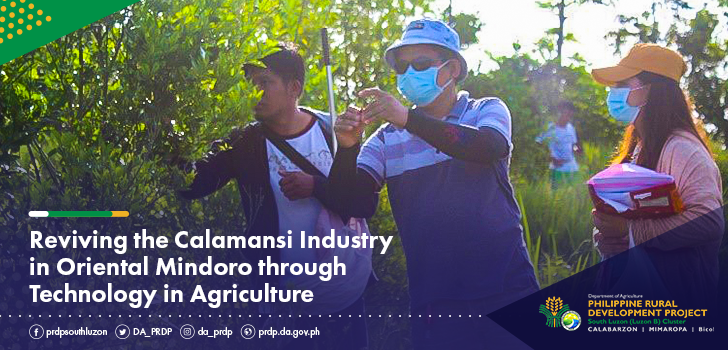
Reviving the Calamansi Industry in Oriental Mindoro through Technology in Agriculture
Once hailed as the “Calamansi King of the Philippines”, Oriental Mindoro used to produce more than a hundred metric tons of calamansi annually.
However, the province faced a decline in production in the past few years.
According to Mindoro State University Director for Research and Development Macario Masagca Jr., one of the main reasons of decline was the conversion of calamansi farms into other fruit trees.
Seeking to reclaim its prestigious title as Calamansi King, the project “Study on Pest and Diseases of Calamansi: Paving Ways for the Sustainability of Calamansi Industry in Oriental Mindoro” was formed, in partnership with the Department of Agriculture – Philippine Rural Development Project (DA-PRDP).
The overall objective of the project study is aimed at institutionalizing a means to produce disease-free calamansi fruits through profiling pests and diseases found in calamansi, the development of a mobile application to store the results of the profiling, and the establishment of a grove and net house to facilitate further experimental studies.
Laying the Foundations of the Project Study
Since the start of the project in December 2020, several outputs have been provided by the research team to kickstart the revival of the calamansi industry.
In March 2021, the project study team conducted field visits to several calamansi farms all over Oriental Mindoro. Concerns such as cultural management practices, calamansi production per area in hectares, and varietal identification were addressed, among others.
However, given the public health situation in the country, the field visits didn’t come free of challenges.
“Under the pandemic, each municipality has their own travel restrictions. In fact, we’re not able to survey and profile [calamansi farmers] in Calapan yet because of strict [health protocols]. It was a struggle to coordinate with farmers as well. Some farmers don’t have contact numbers, while some live-in remote areas where we have to cross rivers, or climb mountains to reach their calamansi farm,” shared Research Assistant Jayvee Cueto.
Seeking Assistance through Calamanseek
The project study entitled “Study on Pest and Diseases of Calamansi: Paving Ways for the Sustainability of Calamansi Industry in Oriental Mindoro” aims to institutionalize a means to produce disease-free calamansi fruits. This is done by profiling pests and diseases of calamansi, developing a mobile application to store the results of the profiling, and establishing a grove and net house to facilitate further experimental studies.
For the mobile application called CalamanSeek, calamansi farmers will be able to enjoy both online and offline features. The offline features of the application will serve as a readily available reference for farmers when it comes to identifying and treating calamansi pests and diseases. On the other hand, through the online features, calamansi farmers can freely consult their concerns with experts and professors from the Mindoro State University.
Foundation Grove and Net House for Calamansi
With the help of the Mindoro State University, the project study allotted 1.55 hectares of land in Brgy. Alcate in the Municipality of Victoria for a foundation grove and net house. The foundation grove will serve as a laboratory and pest clinic. Once the foundation grove successfully shelters 625 calamansi trees, further experiments on calamansi pests and diseases will be conducted. The net house, on the other hand, will serve as a nursey to house pest-free calamansi planting materials.
Next Steps
The project is currently nearing its completion with almost 85% of the data already turned in (as of September 3, 2021). Once the data is completed and encoded in the CalamanSeek mobile application, the team will then go back to the calamansi farmers they profiled to introduce the new technology.
When asked about his message to funding initiatives like DA-PRDP, Masagca expressed his wish for more support for dying industries. “I hope that struggling industries like the calamansi industry, industries that are beginning to lose hope, will be prioritized. In the time of climate change and natural disasters, calamansi and calamansi products struggle to compete with other commodities in terms of prioritization. So, we hope that initiatives like this will be funded continuously so we can revive the industry,” said Masagca. (Danica A. Brutas, DA-PRDP MIMAROPA RPCO InfoACE Unit)

Project study team visit calamansi farms early in the morning to collect calamansi pests (Photo from Macario Masagca, Jr.)

Amidst travel restrictions, the project study team coordinates with Municipal Agricultural Offices to reach and interview calamansi farmers in the province (Photo from Macario Masagca, Jr.)
